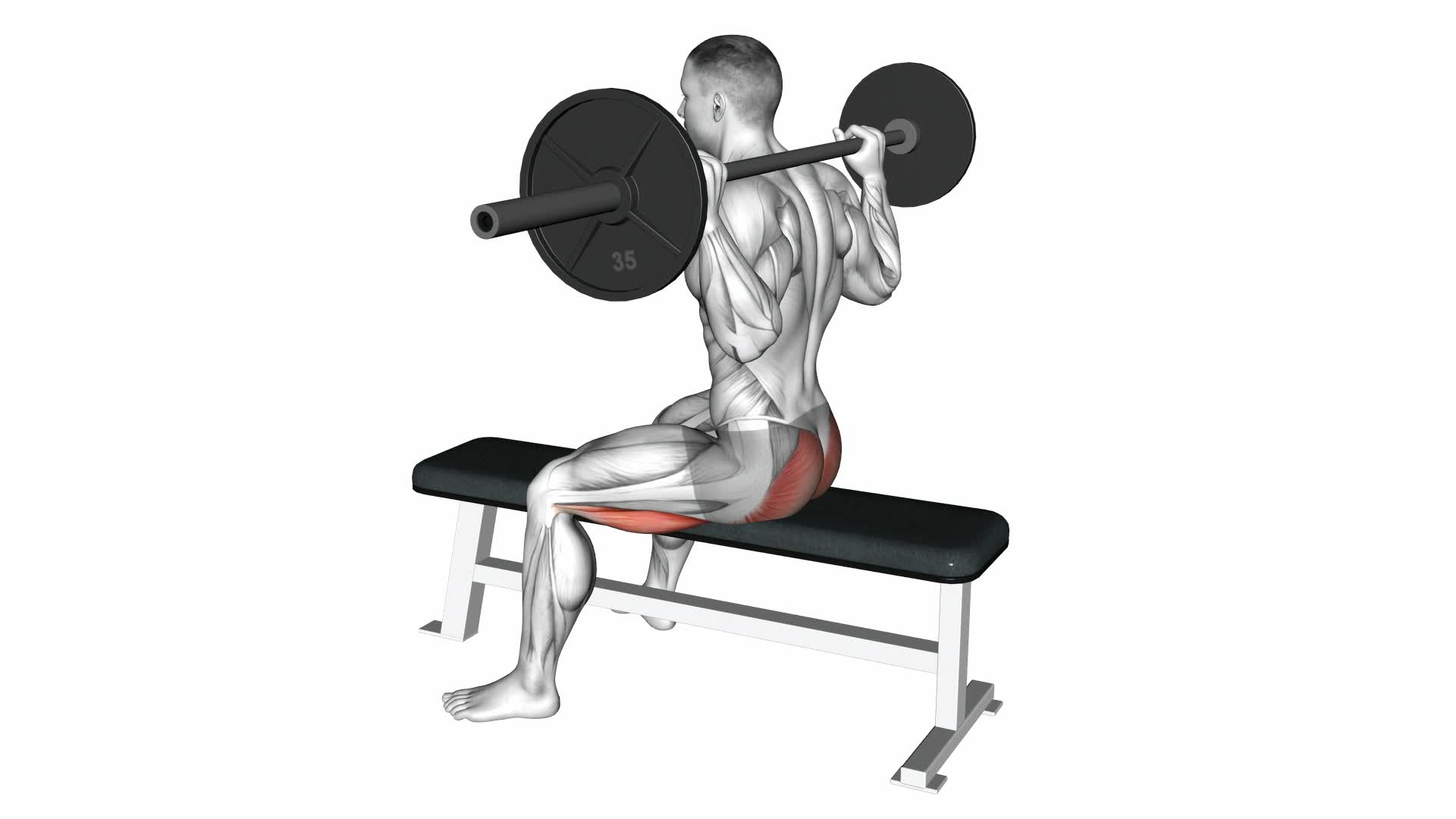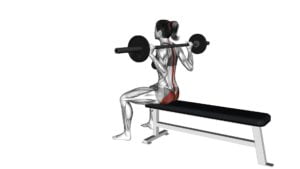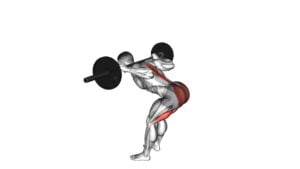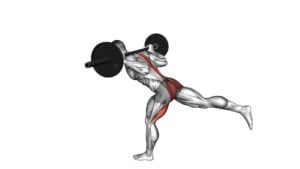Barbell Seated Good Morning – Video Exercise Guide & Tips

Are you looking to strengthen your core and lower back? The Barbell Seated Good Morning is the perfect exercise for you. In this video exercise guide, we will show you the proper set-up, step-by-step instructions, and tips for increasing the intensity of this exercise.
Watch This Exercise Video
Whether you're a beginner or an advanced fitness enthusiast, we've got safety precautions and modifications to suit your needs. Get ready to take your workout to the next level with the Barbell Seated Good Morning.
Key Takeaways
- Barbell Seated Good Morning improves posture and strengthens the lower back.
- It targets the hamstrings and hip flexors while building a strong and stable core.
- The exercise can be enhanced by using different grip positions, incorporating alternative exercises, and increasing intensity gradually.
- Safety precautions, such as maintaining controlled movements and modifying the exercise based on individual fitness levels, should be followed.
Benefits of the Barbell Seated Good Morning
You will experience multiple benefits from incorporating the Barbell Seated Good Morning into your workout routine. This exercise is highly effective in improving posture and strengthening the lower back. By engaging the muscles in your lower back, including the erector spinae and the glutes, the Barbell Seated Good Morning helps to build a strong and stable core. This, in turn, improves your overall posture and reduces the risk of developing back pain or injury.
The Barbell Seated Good Morning also targets your hamstrings and hip flexors. As you perform the exercise, these muscles are stretched and strengthened, contributing to improved hip mobility and flexibility. This can be particularly beneficial for athletes or individuals involved in activities that require explosive movements or a wide range of motion.
Additionally, incorporating the Barbell Seated Good Morning into your workout routine can enhance your overall performance in other exercises, such as squats and deadlifts. The exercise helps to develop the necessary strength and stability in the lower back, which is essential for executing these compound movements with proper form and technique.
Proper Set-Up and Equipment for the Exercise
To properly set up and perform the Barbell Seated Good Morning exercise, it's important to ensure the correct equipment is used. The main piece of equipment needed for this exercise is a barbell. Make sure the barbell is loaded with the appropriate weight for your fitness level and goals. It's essential to choose a weight that challenges you but still allows you to maintain proper form throughout the movement.
When setting up for the Barbell Seated Good Morning, begin by sitting on a bench with your feet flat on the floor and your knees bent at a 90-degree angle. Place the barbell across your upper back, resting it on your trapezius muscles. Use a grip that's comfortable for you, either a wide or narrow grip.
Maintaining proper form throughout the exercise is crucial to prevent injury and maximize results. Keep your chest up and your back straight as you hinge forward at the hips. Lower your torso towards the floor, keeping your spine neutral and engaging your core. Once you reach a comfortable range of motion, push through your heels and squeeze your glutes to return to the starting position.
Step-by-Step Guide to Performing the Barbell Seated Good Morning
To perform the Barbell Seated Good Morning exercise, begin by ensuring you have the proper equipment and set-up in place. Sit on a bench with your feet shoulder-width apart and firmly planted on the ground. Place a barbell across your upper back, resting it on your trapezius muscles, and grip it with an overhand grip slightly wider than shoulder-width apart. Keep your chest up, shoulders back, and maintain a neutral spine throughout the exercise.
To initiate the movement, hinge forward at the hips while keeping your back straight and your core engaged. Lower your torso until it's parallel to the ground, feeling a stretch in your hamstrings and glutes. Pause briefly at the bottom of the movement, then reverse the motion by driving your hips forward and returning to the starting position.
It is important to note that there are variations of the barbell seated good morning that you can incorporate into your workout routine. These include using different grip positions, such as a snatch grip or a close grip, to target different muscle groups. Additionally, you can use different equipment, such as dumbbells or resistance bands, to add variety and challenge to the exercise.
If you're looking for alternative exercises to target the posterior chain, you can try exercises like the Romanian deadlift, hip thrusts, or glute bridges. These exercises can help strengthen and tone your hamstrings, glutes, and lower back, providing a well-rounded workout for your posterior chain.
Common Mistakes to Avoid
To avoid common mistakes, it's important to be aware of the proper form and technique when performing the barbell seated good morning exercise. One common mistake to watch out for is rounding your back. It's crucial to maintain a neutral spine throughout the movement to prevent injury and ensure effective targeting of the muscles.
Another mistake is using too much weight. Start with a lighter load and gradually increase as you become more comfortable and confident with the exercise. Using excessive weight can compromise your form and put unnecessary strain on your lower back.
Additionally, avoid locking your knees during the exercise. Keep a slight bend in your knees to engage your hamstrings and glutes properly.
Lastly, make sure to control the movement throughout the exercise. Avoid jerking or using momentum to lift the weight. Instead, focus on using your hamstrings and glutes to initiate the movement and maintain control.
By paying attention to these common mistakes and maintaining proper form, you can maximize the effectiveness and safety of the barbell seated good morning exercise.
Now, let's move on to some tips for increasing the intensity of the exercise.
Tips for Increasing the Intensity of the Exercise
To increase the intensity of the barbell seated good morning exercise, you can start by adding more weight to the barbell. This will challenge your muscles and make the exercise more difficult.
Additionally, you can change the tempo of the exercise by performing it at a slower pace, emphasizing the eccentric phase. This will further engage your muscles and increase the intensity of the exercise.
Adding More Weight
To increase the intensity of the barbell seated good morning exercise, you can add more weight. Adding more weight not only challenges your muscles further, but also helps you progress and achieve better results. Here are some tips for increasing the intensity by adding more weight:
- Start with small increments: Gradually increase the weight to avoid straining your muscles or compromising your form.
- Maintain proper form: Ensure your back is straight, core engaged, and shoulders pulled back throughout the exercise.
- Use a spotter: When adding heavy weights, it's important to have a spotter to ensure safety and provide assistance if needed.
- Focus on controlled movements: Slowly lower your torso towards the ground and raise it back up, maintaining control throughout the exercise.
- Listen to your body: Pay attention to any discomfort or pain and adjust the weight accordingly to avoid injury.
Changing the Tempo
To increase the intensity of the barbell seated good morning exercise, you can change the tempo, which involves altering the speed at which you perform the movement. By varying the tempo, you can increase the difficulty of the exercise and further challenge your muscles.
There are different tempo variations you can try to make the exercise more intense. One option is to perform the movement at a slower pace, taking more time during the eccentric (lowering) phase and the concentric (raising) phase of the exercise. This forces your muscles to work harder and increases time under tension, leading to greater muscle activation and growth.
Another variation is to perform the exercise at a faster tempo, which can increase the cardiovascular demand and enhance the overall challenge of the exercise.
Experiment with different tempos to find what works best for you and your fitness goals.
Safety Precautions and Modifications for Different Fitness Levels
Before attempting the Barbell Seated Good Morning exercise, it's important for you to consider safety precautions and modifications based on your fitness level. This will help ensure that you perform the exercise correctly and reduce the risk of injury. Here are some safety modifications and beginner modifications to keep in mind:
- Start with a lighter weight: If you're new to this exercise or just starting out, it's important to begin with a lighter weight to allow your body to adapt and build strength gradually.
- Use a spotter or safety pins: Since the Barbell Seated Good Morning involves a barbell placed across your shoulders, it's a good idea to have a spotter or use safety pins to catch the weight in case you lose control or struggle to complete the movement.
- Focus on form and technique: Proper technique is crucial to performing this exercise safely. Make sure you maintain a neutral spine, engage your core, and keep your movements controlled and smooth throughout the exercise.
- Listen to your body: Pay attention to any discomfort or pain during the exercise. If something doesn't feel right, stop immediately and consult with a fitness professional or trainer.
- Progress gradually: As you become more comfortable and confident with the Barbell Seated Good Morning, you can gradually increase the weight and intensity of the exercise.
Frequently Asked Questions
Can the Barbell Seated Good Morning Be Performed Without a Barbell?
Yes, you can perform a bodyweight alternative to the barbell seated good morning. This exercise is often called the bodyweight seated good morning.
While the barbell version offers added resistance, the bodyweight alternative still provides numerous benefits. It targets your hamstrings, glutes, and lower back, helping to strengthen and tone those muscles. Additionally, it can improve your posture and stability.
Give it a try if you don't have access to a barbell or want to switch up your routine.
How Often Should the Barbell Seated Good Morning Be Included in a Workout Routine?
When it comes to including the barbell seated good morning in your workout routine, it's important to consider the benefits it offers. This exercise targets your lower back, glutes, and hamstrings, helping to strengthen and tone those areas.
As for how often to include it, aim for 2-3 times a week, allowing for proper rest and recovery. Remember to always maintain proper form and technique, keeping your back straight and bending at the hips.
Are There Any Alternatives to the Barbell Seated Good Morning That Target the Same Muscle Groups?
Looking for alternatives to the barbell seated good morning that target the same muscle groups?
Well, there are a few options you can consider.
One alternative is the Romanian deadlift, which also works the hamstrings and glutes.
Another option is the hip thrust, which specifically targets the glutes.
Lastly, you can try the single-leg deadlift, which engages the hamstrings, glutes, and core.
These exercises can provide variety to your routine while still working the same muscle groups.
Can the Barbell Seated Good Morning Help With Lower Back Pain?
The barbell seated good morning is an exercise that can help with lower back pain. It targets and strengthens the muscles in your lower back, which can provide support and alleviate discomfort.
Additionally, the barbell seated good morning can improve your posture by strengthening your core muscles and promoting proper alignment.
While there are alternatives to this exercise that target similar muscle groups, the barbell seated good morning offers unique benefits for lower back pain and posture improvement.
Is It Safe to Perform the Barbell Seated Good Morning if I Have a History of Back Injuries?
If you have a history of back injuries, it's important to exercise caution when considering barbell exercises.
While the barbell seated good morning can be effective for strengthening the lower back and hamstrings, it may not be safe for everyone.
Consult with a healthcare professional or a certified trainer who can assess your specific condition and provide recommendations for back injury prevention exercises that are suitable for you.
Conclusion
In conclusion, the barbell seated good morning is a highly effective exercise for targeting the lower back and glute muscles. By following the proper set-up and equipment guidelines, as well as the step-by-step guide, you can perform this exercise safely and efficiently.
Avoiding common mistakes and incorporating intensity-boosting tips will further enhance your results. Remember to prioritize safety and make necessary modifications based on your fitness level.
With consistency and proper form, you can reap the benefits of this challenging exercise.

Author
Years ago, the spark of my life’s passion ignited in my mind the moment I stepped into the local gym for the first time. The inaugural bead of perspiration, the initial endeavor, the very first surge of endorphins, and a sense of pride that washed over me post-workout marked the beginning of my deep-seated interest in strength sports, fitness, and sports nutrition. This very curiosity blossomed rapidly into a profound fascination, propelling me to earn a Master’s degree in Physical Education from the Academy of Physical Education in Krakow, followed by a Sports Manager diploma from the Jagiellonian University. My journey of growth led me to gain more specialized qualifications, such as being a certified personal trainer with a focus on sports dietetics, a lifeguard, and an instructor for wellness and corrective gymnastics. Theoretical knowledge paired seamlessly with practical experience, reinforcing my belief that the transformation of individuals under my guidance was also a reflection of my personal growth. This belief holds true even today. Each day, I strive to push the boundaries and explore new realms. These realms gently elevate me to greater heights. The unique combination of passion for my field and the continuous quest for growth fuels my drive to break new ground.







